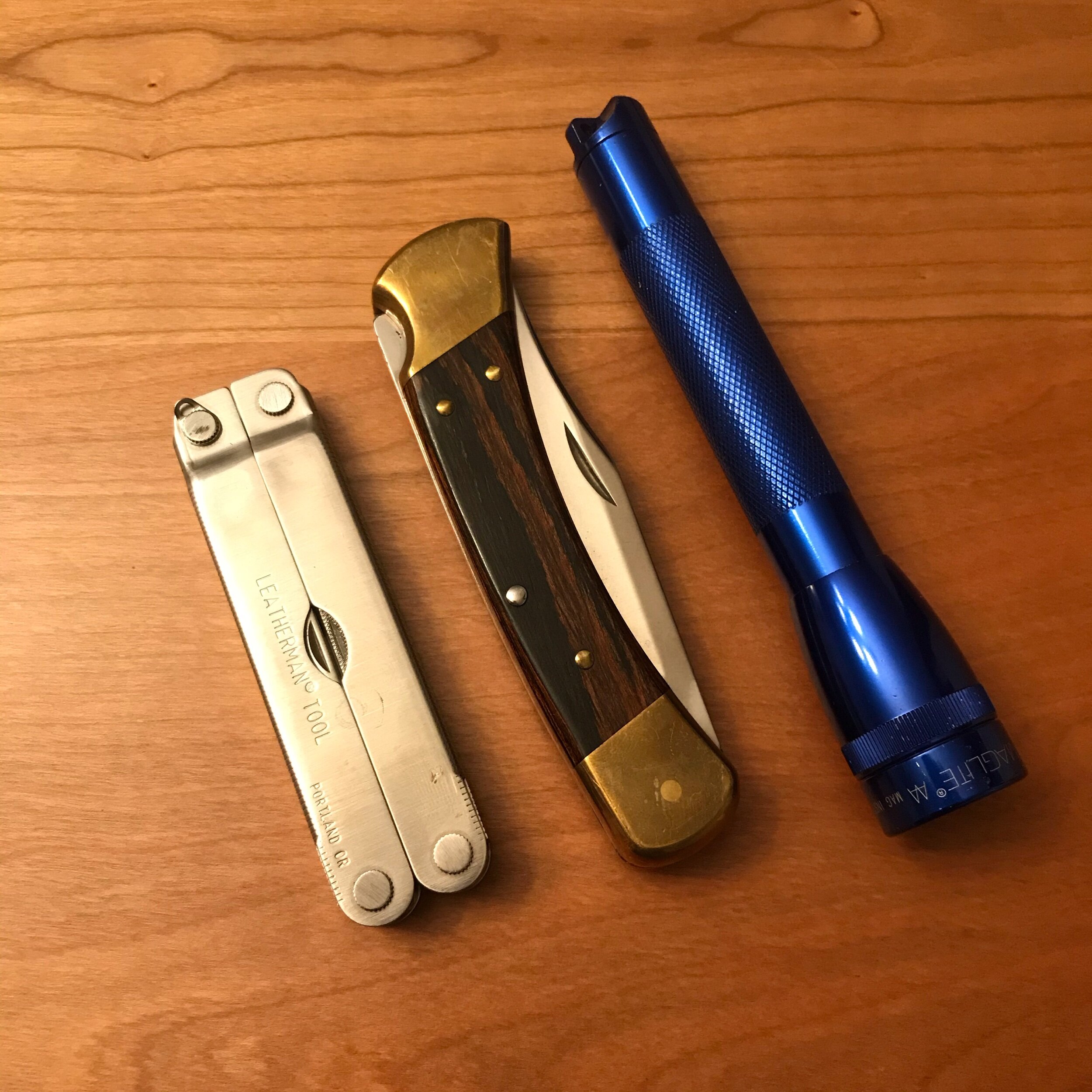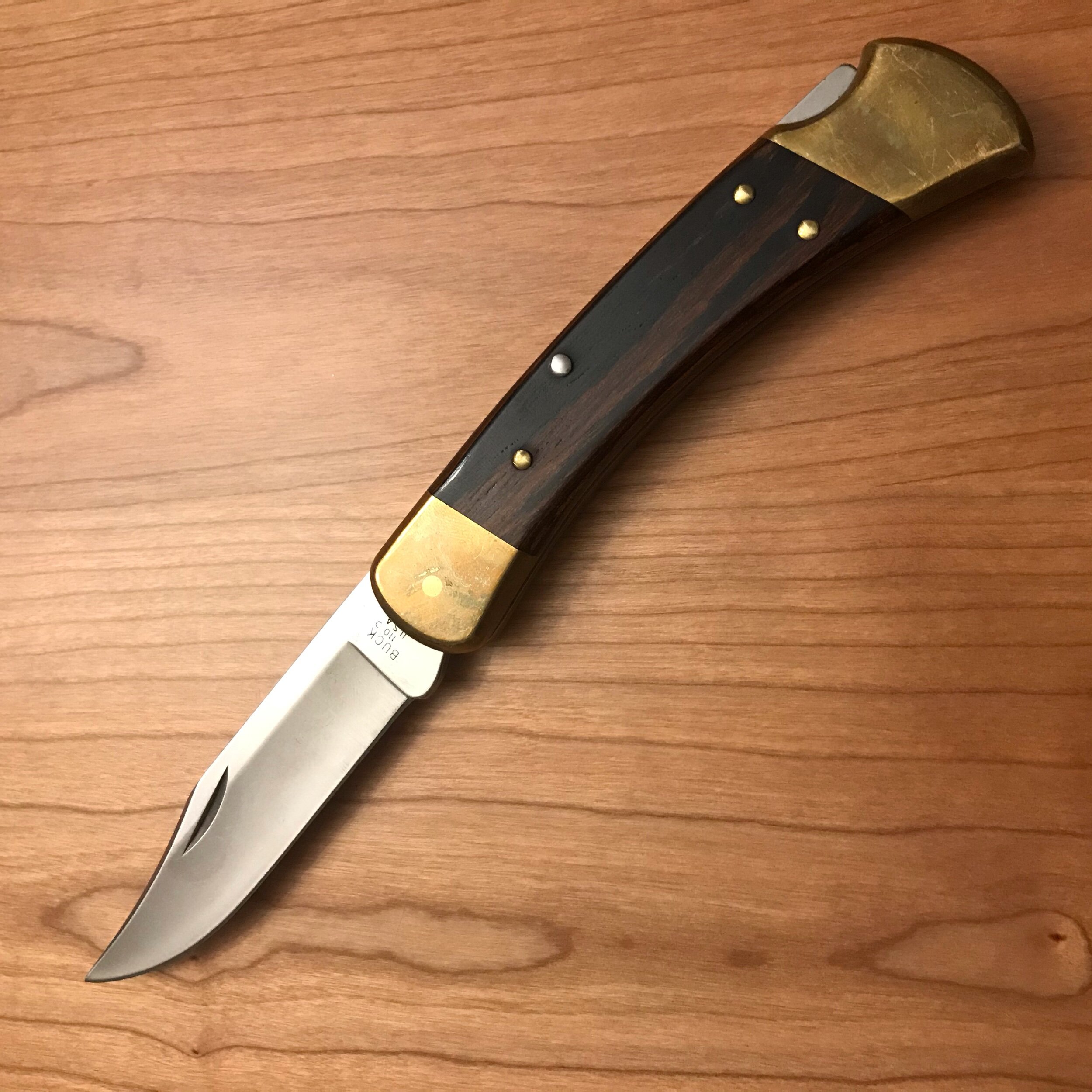Reviewing Classics
Gear, like most things, is getting better over time. For example, most people conceive of Mickey Mantle as this spry yet behemoth outfielder for the Yankees, but a quick check shows that he was much closer in height to Jose Altuve than Aaron Judge (Mantle: 5’ 11”; Jose Altuve: 5’6”; and Aaron Judge: 6’7”). Cars get faster, athletes more athletic, and technology more powerful. And so, what was good in EDC (even before we called it that) in 1985 is no longer state of the art. But how far behind the curve are the original Buck 110, the Maglight Mini Mag, and the Leatherman PST? Well, let’s see.
All three of these items were part of my stash of gear I received from my Grandfather upon his death a few years ago. They were, like all of his tools, religiously cared for and never abused. The PST could easily pass as brand new. He lubed everything and sharpened with machine-like precision, even on stones. You cannot tell where the factor edge ends and his edge begins on either the PST or the 110. Of course the 110’s brass (!) bolsters are bit worse for wear as they have a bit of patina, but none of the functional parts on any of these tools looks like nothing other than brand new. He had a small bumper sticker in the shed behind his house that read: Take care of your tools and they will take care of you. He is also the son of a moonshiner that even in the late 1990s still made moonshine in his basement still that was, at that point about 80 years old. My great grandfather was between 93 and 96 at the time (he died, cigarette in his hand at 103, 104, or 105–floods wiped out four years of birth certificates in his hometown). I come from a long line of tool people and neat freaks. Given this and my experience with these tools myself, I feel it is fair to treat them as if they were new for purposes of these reviews.
Buck 110
We know what a modern 110 would look like because Buck made it—the 110 Slim Pro. That knife was a darn good knife, and the original, while lacking a clip and being about 8 ounces heavier than I like, is still, fundamentally a very competent knife. I actually like the 112’s size better, but the 110 is slicey (apparently, it never occurred to Chuck Buck to make a big knife that couldn’t cut…funny how that worked out so well and so many makers these days ignore that fact) and good in the hand. The lock is pretty darn strong and nail nick isn’t great, making the whole thing problematic in opening and closing. This and the weight are where the original 110 shows its age. But even with these drawbacks, this is still a decent choice today and pretty darn great if you are into big knives. Only the Spyderco Military is in the same class in terms of slicing ability. The rest of the beefy knives made today cut like canoe paddle.
Overall Score: 13 out of 20 (2 off for each of the following: Carry and Deployment; 1 off for each of the following: Design, Fit and Finish, Steel); 1985 Score: 17 out of 20 (2 off for Carry; 1 off for Fit and Finish).
Maglight Mini Mag
The most popular flashlight in the world is really more of a feat of industrial production than it is of industrial design. Through careful management of the production process Mag has managed to keep the Mini Mag the same price since the day of its release all those years ago. While interesting for Wharton types, that is not so interesting for those of us that appreciate good flashlights. And, well, this was never a good flashlight, even when it was state of the art. It is certainly a step up from those plastic tubes that came with a pack of Energizer batteries, but those were more platforms to sell batteries than they were tools for illumination. Among those lights, the Mini Mag was, to borrow a phrase from Nick, the best looking guy at the leper colony. The jump from Mini Mag to Surefire 6P (side note: Surefire please bring back the original 6P and just leave it in production…there is so much goodness there and a booming aftermarket) was tremendous. While one is about five times more than the other, the more expensive light is roughly 20 times better. The beam here is especially miserable, something like the flashlight equivalent of leprosy—spotted, sickly, and misshapen. Even the LED version doesn’t improve the situation much. The twisty is counterintutive and the light rattles like a tamboreen. The whole thing is a mess…expect for the body tube. The aluminum is expertly finished and exudes quality. This is why people, to this day, mod the crap out of their Mini Mags. Great body tube, wretched light. Obviously there is no real UI as there is only one output.
Overall Score: 5 out of 20 (2 points off for each of the following: Design, Carry, Beam Type, Beam Pattern, Output, Runtime, UI; 1 point off for Hands-Free); 1985 score: 11 out of 20 (2 points off for each of the following: Beam Type, Beam Pattern, Output, Runtime; 1 point off for Hands Free).
Leatherman PST
Ever have that sensation when you look back at pictures from your childhood and think—oh god I was so awkward? Yeah, that is what Leatherman must think seeing the PST. Over and over again during use I just couldn’t shake the fact that this tool, while a huge conceptual leap from the knife-based multitools, is exceptionally awkward all of the time. One weird thing, something I only noticed after carrying the PST for a few days—the knife is in the wrong spot. It opens such that the edge is off line with the handle, resulting in a huge gap.
You basically can use the belly and the tip, but nothing else on a surface. And this is emblematic of the rest of the tool. The handles seem almost designed to cause hotspots with no thought to rounding over surfaces or making things more pleasant in hand. Oddly, the pliers are really outstanding with precise, well-matched tips. The tool is, of course, heavy and clunky, and the leather carry case is basically a box with a belt loop. Its kind of stupid. But such is the price of innovation—rarely is the first some something polished and thoroughly conceived.
Overall Score: 8 out of 20 (2 off for: Design, Grip, Carry, Deployment/Accessibility, Retention Method; 1 off for: Materials, Tool Selection); 1985 Score: N/A this was the only game in town…so its hard to evaluate the PST in context of the time.
The Mini Mag is a horrendous light today and it wasn’t all that great at the time, its just that everything else was simply terrible. The 110, obviously, fares the best because, well, it is a classic. It is hard to know what the PST was like at the time because, well I was 8 and there was no competition. I do remember using this very same 110 and being impressed at is cutting ability then and I also remember the Mag and thinking “this is better than other stuff, but I wish it….” a lot.
The other interesting aspect of this thought experiment is that it meshes very well with my intuitions of these products today. Knives aren’t really tech pieces. Sure steels get better, but that is basically it. A knife is all about good design. A flashlight, on the other hand, is basically a computer with one function. As such, they will get better faster than knives. So in looking back, its clear that we have seen seismic shifts in light tech. Knives are better, but not really because of the steel (Buck’s 420HC is actually still pretty good). Clips, better deployment, and better locks aren’t necessarily changes brought by technology, but changes brought about by good design (see: Sal Glesser). Multitools are more like knives in this regard, but they are more complex and thus require more design solutions. Comparing the PST to the Skeletool is telling—there is lots that need to be improved on the PST. But going from zero to something is a huge leap.
My 1985 EDC was heavy, poor performing, and not that small. The knife clearly fairs the best and the light the worst. It wouldn’t be horrible to carry this stuff today, but with so much quality on the market why waste time with substandard stuff. If I were assembling a similar kit today it would probably be the 47s Quark QK16L, the Buck 110 Slim Pro, and the Leatherman Skeletool CX. And that stuff, well, it blows this stuff away. Its a good time to be a Gear Geek.
Amazon Purchase Links:
If you want to support the blog and are interested in the gear mentioned here, follow the links below and purchase items—the proceeds help buy new review samples to keep the blog running and 100% independent:






